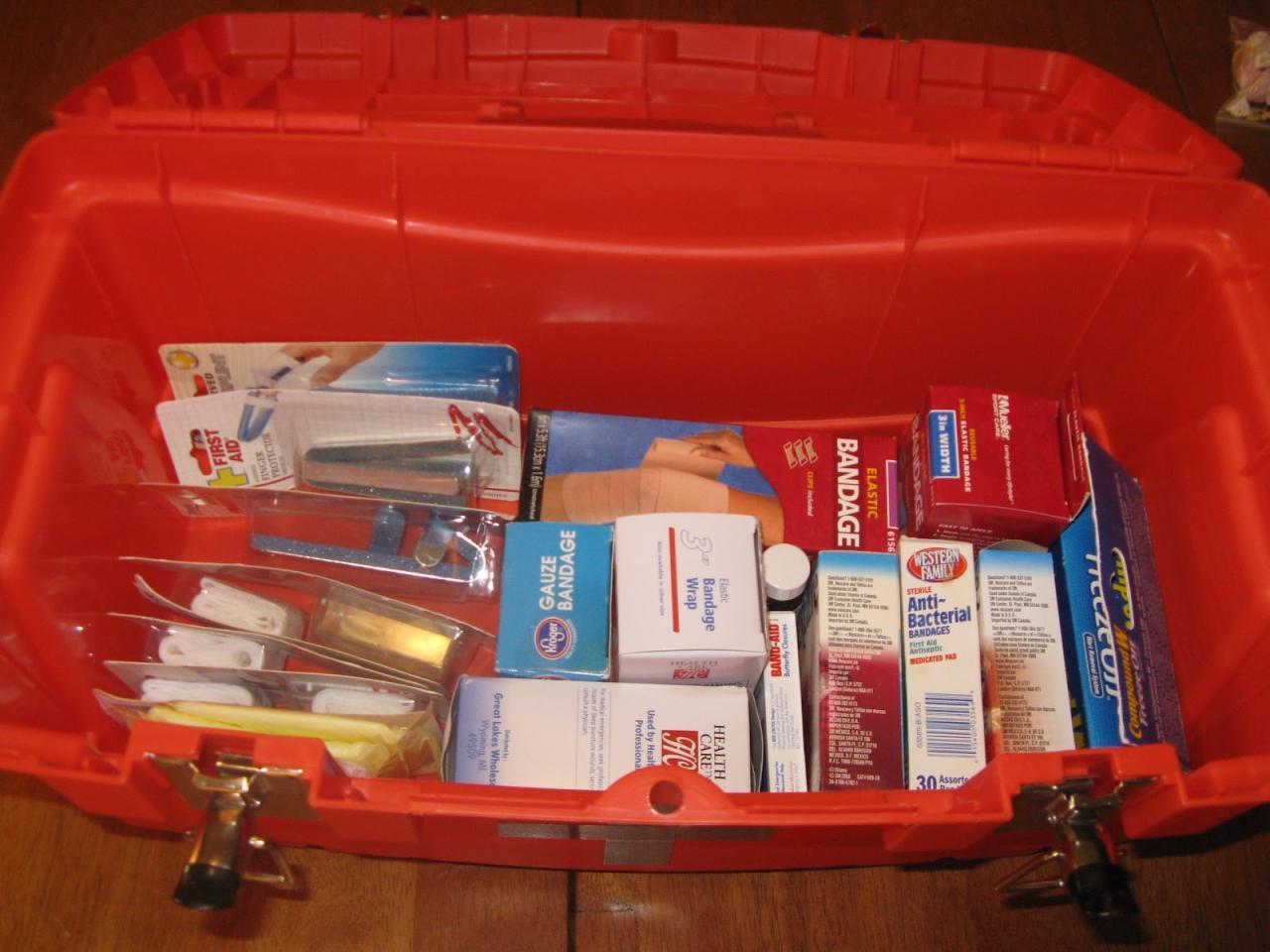Embarking on the digital nomad lifestyle often involves venturing into unfamiliar territories. This comprehensive guide provides a crucial framework for assembling a robust first-aid kit, ensuring you’re prepared for potential health concerns, both minor and significant, during your travels. From essential medications to practical safety measures, this resource will equip you with the knowledge and tools necessary to navigate the world with confidence and peace of mind.
This guide meticulously details the essential elements for a well-rounded digital nomad first-aid kit. It covers a broad spectrum of considerations, from physical health and safety precautions to critical medical supplies and emergency preparedness. This approach emphasizes the importance of proactive planning and preparedness, allowing you to prioritize your well-being and confidence during your adventures.
Defining the Digital Nomad Lifestyle
A digital nomad is an individual who works remotely and travels the world while maintaining their professional commitments. This lifestyle is characterized by a flexible work schedule, the ability to work from anywhere with an internet connection, and a desire for location independence. This unique approach to work allows for a rich blend of professional fulfillment and personal exploration.The typical digital nomad juggles various tasks, including project management, client communication, and administrative duties, all while maintaining a professional image and reputation.
This lifestyle demands significant self-discipline, organization, and time management skills. This freedom also comes with the responsibility of staying productive and maintaining professional standards, even in unfamiliar environments.
Key Characteristics of the Digital Nomad Lifestyle
The core of the digital nomad lifestyle revolves around adaptability and flexibility. Digital nomads often embrace change, adapting to new environments, cultures, and routines with ease. This adaptability is crucial for success in this dynamic lifestyle.
- Location Independence: Digital nomads work from various locations, including co-working spaces, cafes, and even remote locations. This freedom allows them to experience different cultures and environments.
- Flexible Work Schedule: The digital nomad’s schedule is often dictated by project needs, deadlines, and personal preferences, leading to a dynamic work-life balance.
- Remote Work: Digital nomads use technology to connect with clients, colleagues, and collaborators from anywhere with a reliable internet connection. This characteristic allows for increased freedom in choosing work location.
Typical Activities and Responsibilities
Digital nomads engage in a wide range of activities, reflecting their diverse skill sets and work styles. Their responsibilities typically include client communication, project management, and administrative tasks.
- Client Interaction: Digital nomads maintain communication with clients through various channels, such as email, video conferencing, and instant messaging, to ensure project progress and client satisfaction.
- Project Management: Organizing and managing tasks, setting deadlines, and coordinating with team members are crucial responsibilities for a digital nomad.
- Administrative Duties: Tasks like managing finances, scheduling appointments, and handling travel arrangements are essential for maintaining a smooth work and personal life balance.
Importance of Adaptability and Flexibility
The digital nomad lifestyle is inherently dynamic, demanding constant adaptation and flexibility. This includes adjusting to different time zones, cultural norms, and unexpected circumstances.
“Adaptability is the key to navigating the ever-changing landscape of the digital nomad lifestyle.”
Common Challenges Faced by Digital Nomads
Digital nomadism, while offering freedom, also presents challenges that require proactive solutions.
| Challenge | Potential Solution |
|---|---|
| Internet Connectivity Issues | Investing in reliable VPN services, using mobile hotspots, and having backup internet plans can help address this concern. |
| Cultural Differences and Language Barriers | Learning basic phrases in local languages, researching cultural norms, and being open-minded can help mitigate these challenges. |
| Maintaining Work-Life Balance | Creating clear boundaries between work and personal time, practicing self-care, and scheduling downtime are essential. |
| Isolation and Loneliness | Joining online communities, participating in local events, and fostering relationships with fellow nomads can help combat this. |
| Financial Management | Creating a detailed budget, exploring cost-effective accommodation options, and researching visa requirements for different countries can help manage finances effectively. |
| Security Concerns | Researching local laws and customs, taking necessary precautions for personal safety, and using secure online platforms can address security issues. |
Essential Tools and Technologies

A successful digital nomad lifestyle hinges on having the right tools and technologies to seamlessly manage work and personal life while traveling. This section Artikels the essential tools, categorized by their function, along with explanations of their importance and comparative analyses to help you make informed choices. This detailed overview will empower you to select the optimal tools to support your nomadic journey.
Communication Tools
Effective communication is crucial for maintaining professional connections and personal relationships while on the move. A reliable communication platform allows you to stay in touch with clients, colleagues, and loved ones, ensuring smooth workflow and personal well-being.
- Messaging Platforms: Platforms like WhatsApp, Telegram, and Slack are essential for instant communication, group chats, and file sharing. Their widespread use and ease of integration with other tools make them invaluable for both personal and professional interactions.
- Video Conferencing Software: Zoom, Google Meet, and Microsoft Teams enable real-time video calls, crucial for client meetings, team collaborations, and virtual social gatherings. The ability to conduct professional meetings remotely is critical for digital nomads.
- Dedicated VoIP Phones: Consider using a VoIP phone service (like RingCentral or Google Voice) for phone calls and SMS, offering flexibility and often better rates than traditional landlines, especially when combined with a VPN for secure communication.
Productivity Tools
Digital nomads need robust tools to manage their tasks, projects, and schedules effectively. These tools ensure high productivity and organization.
- Project Management Software: Asana, Trello, and Monday.com offer a range of features to manage tasks, projects, deadlines, and collaborations, essential for staying organized and meeting commitments.
- Note-Taking Apps: Evernote, OneNote, and Bear provide versatile note-taking capabilities for capturing ideas, research, and meeting minutes, fostering better knowledge management.
- Calendar Applications: Google Calendar, Outlook Calendar, and Apple Calendar help manage schedules, appointments, and deadlines, ensuring efficient time management and avoiding scheduling conflicts.
Internet Access Tools
Reliable internet access is fundamental for a digital nomad’s work and daily life. The right tools ensure seamless connectivity and productivity regardless of location.
- VPN Services: A Virtual Private Network (VPN) is vital for secure and private internet access, especially when using public Wi-Fi. VPNs encrypt data and mask your IP address, safeguarding your personal information and online activities.
- Portable Wi-Fi Hotspots: Pocket-sized Wi-Fi hotspots allow you to connect to the internet from anywhere with cellular coverage. This is a convenient backup to public Wi-Fi, ensuring connectivity in areas with limited or unreliable public access.
- Mobile Data Plans: A robust mobile data plan allows for internet access on the go. Data plans with high-speed and large data allowances are crucial for consistent internet access.
Comparison Table: Communication Tools
| Category | Tool | Pros | Cons |
|---|---|---|---|
| Messaging | Widely used, free messaging, group chats | May not be suitable for large teams, limited features compared to Slack | |
| Messaging | Slack | Robust features, file sharing, dedicated channels for teams | Subscription required, can be overwhelming for individuals |
| Video Conferencing | Zoom | Easy to use, various features (screen sharing, breakout rooms) | Potential for security concerns, can be resource-intensive |
| VoIP | RingCentral | Professional-grade phone service, features for remote teams | Requires a subscription, may not be as user-friendly as other options |
Setting Up a VPN
| Step | Procedure |
|---|---|
|
1. Subscription |
Choose a VPN provider and subscribe to a plan. |
|
2. Download |
Download and install the VPN client software on your devices (computer, phone). |
|
3. Login |
Log in using your VPN credentials. |
|
4. Connect |
Select a server location (often recommended to connect to a server near your current location for optimal speed). |
|
5. Verification |
Verify the VPN connection by checking your IP address. |
Digital Wellbeing and Productivity
Maintaining a healthy work-life balance is crucial for digital nomads, allowing them to sustain their nomadic lifestyle and prevent burnout. Sustained focus and productivity are directly linked to emotional and mental well-being. A dedicated approach to digital well-being allows for more efficient work and a richer personal experience.Digital nomads often face unique challenges in managing their time and attention.
Distractions abound in unfamiliar environments, and the constant connectivity can blur the lines between work and personal life. Strategies for digital well-being are therefore vital for successful and fulfilling nomadic journeys.
Importance of Digital Well-being
Digital well-being encompasses more than just avoiding distractions. It’s about actively fostering a healthy relationship with technology. This includes recognizing the potential for technology to be both a powerful tool and a source of stress. By prioritizing digital well-being, digital nomads can enhance their overall productivity and well-being. Effective strategies help them avoid information overload, manage screen time, and foster a positive mindset.
Managing Distractions and Optimizing Productivity
Managing distractions is paramount for maintaining productivity. Creating dedicated workspaces, even in temporary locations, can help establish boundaries. Utilizing tools like website blockers and focused work sessions (e.g., the Pomodoro Technique) can significantly reduce distractions and enhance concentration.
- Dedicated Workspaces: Creating a designated workspace, even if it’s a corner in a cafe or a co-working space, helps separate work from leisure activities, increasing focus. This physical separation aids in mental compartmentalization.
- Time Management Techniques: Implementing time management strategies, like the Pomodoro Technique, which involves working in focused intervals with short breaks, can enhance productivity. This structured approach helps maintain momentum and prevents burnout.
- Distraction Control: Utilizing website blockers and app-usage limits can help control distractions. Turning off notifications and limiting social media access during focused work periods can significantly improve concentration.
Maintaining Work-Life Balance
Maintaining a healthy work-life balance is critical for long-term success as a digital nomad. This involves setting clear boundaries between work and personal time. Regular breaks, engaging in hobbies, and scheduling downtime are essential components of a balanced lifestyle.
- Clear Boundaries: Defining specific work hours and sticking to them, even when working remotely, is crucial for maintaining a sense of normalcy. This creates a mental separation between work and personal time.
- Scheduling Downtime: Scheduling dedicated time for personal activities, hobbies, and relaxation is vital for preventing burnout. This could involve activities like exercise, reading, spending time in nature, or pursuing personal interests.
- Regular Breaks: Incorporating regular breaks into the workday is vital for maintaining focus and preventing fatigue. Short breaks every hour can help maintain mental acuity.
Common Productivity Pitfalls and Solutions
Common productivity pitfalls for digital nomads include procrastination, lack of structure, and poor time management. These issues can be addressed through effective planning, task prioritization, and the use of productivity tools.
- Procrastination: Breaking down large tasks into smaller, more manageable steps can help combat procrastination. Utilizing to-do lists and task management apps can provide structure and motivation.
- Lack of Structure: Establishing a daily routine, even with flexibility, can create structure and predictability. This routine can help maintain a sense of control and improve focus.
- Poor Time Management: Utilizing time management tools and techniques, such as the Eisenhower Matrix for prioritizing tasks, can significantly improve time management.
Productivity Techniques
Various productivity techniques can be adapted to suit different working styles. The effectiveness of these techniques often depends on individual preferences and work habits.
| Technique | Description | Example |
|---|---|---|
| Pomodoro Technique | Working in focused intervals (e.g., 25 minutes) followed by short breaks. | 25 minutes of focused work followed by a 5-minute break. |
| Time Blocking | Scheduling specific time blocks for different tasks. | Scheduling 2 hours for writing in the morning. |
| Eisenhower Matrix | Prioritizing tasks based on urgency and importance. | Categorizing tasks as urgent/important, urgent/not important, not urgent/important, not urgent/not important. |
| Two-Minute Rule | Completing tasks that take less than two minutes immediately. | Responding to a quick email. |
Physical Wellbeing and Safety
Maintaining a healthy lifestyle is crucial for digital nomads, as constant travel and varied routines can easily disrupt established health habits. Prioritizing physical well-being ensures sustained energy levels, improved focus, and a greater ability to enjoy the nomadic experience. A strong physical foundation supports mental clarity and resilience, which are essential for navigating the challenges of remote work and global travel.A holistic approach to physical well-being is paramount for digital nomads.
This involves recognizing the importance of consistent routines, a balanced diet, and regular physical activity, even in unfamiliar environments. Staying hydrated, managing stress, and prioritizing sleep are all critical components of this approach.
Importance of Consistent Routines
Maintaining a consistent sleep schedule and daily routine, as much as possible, is vital for physical and mental well-being. This helps regulate the body’s natural rhythms and minimizes the impact of jet lag and time zone changes. Even when traveling, establishing a regular wake-up time, meal schedule, and exercise routine can significantly improve overall health and reduce stress.
Essential Practices for Maintaining Physical Health
Regular exercise, regardless of the location, is essential for physical and mental well-being. This could include walking, running, yoga, or gym workouts. Prioritizing a balanced diet, including fruits, vegetables, and lean proteins, is equally crucial. Remember to stay hydrated by drinking plenty of water throughout the day. Finding opportunities for relaxation and stress management techniques like meditation or mindfulness exercises can also be beneficial.
Accessing Healthcare in Different Locations
Knowing how to access healthcare in different locations is essential. Researching local hospitals, clinics, and pharmacies beforehand is advisable. Consider purchasing comprehensive travel insurance that covers medical expenses and repatriation in case of emergency. Many digital nomads also maintain a network of trusted doctors or healthcare providers, enabling them to seek assistance from familiar professionals. Having emergency contact information readily available is also a critical step.
Staying Safe in Unfamiliar Environments
Staying aware of surroundings and practicing basic safety precautions is paramount in unfamiliar environments. Be mindful of your belongings, and avoid walking alone in poorly lit areas at night. Research local laws and customs, and be respectful of cultural differences. Communicating with locals and seeking advice from trusted sources can be beneficial in ensuring safety. Staying connected to friends and family back home through regular communication is another valuable safety measure.
Managing Jet Lag and Time Zone Adjustments
Recognizing and mitigating the effects of jet lag is important for maintaining physical and mental well-being. Adjusting to new time zones gradually by altering sleep schedules in the days leading up to travel can be helpful. Prioritizing sleep, avoiding caffeine and alcohol, and staying hydrated are also effective strategies. Utilizing natural light exposure and engaging in light physical activity upon arrival can also aid in adjusting to the new time zone.
Travel Health Risks and Preventive Measures
| Risk | Prevention |
|---|---|
| Foodborne illnesses | Consume only food from reputable sources, and practice proper hygiene. |
| Waterborne illnesses | Drink bottled water or purified water. Avoid ice made from tap water. |
| Insect-borne illnesses (e.g., malaria, dengue fever) | Use insect repellent, wear protective clothing, and consult a doctor about necessary vaccinations. |
| Sunburn | Apply sunscreen with a high SPF, wear protective clothing, and seek shade during peak sun hours. |
| Altitude sickness | Acclimatize gradually to higher altitudes, stay hydrated, and consult a doctor if experiencing symptoms. |
| Travel-related injuries | Practice safe travel habits, use appropriate safety equipment, and be aware of potential hazards. |
| Infectious diseases | Ensure vaccinations are up-to-date, and practice good hygiene, especially when traveling to areas with high prevalence. |
Financial Planning and Management

Embarking on a digital nomad journey necessitates meticulous financial planning. Proper management of income, expenses, and taxes is crucial for a sustainable and fulfilling lifestyle. This involves understanding the unique financial considerations associated with location independence and implementing strategies for long-term financial security.
Importance of Financial Planning for Digital Nomads
Financial planning is paramount for digital nomads due to the inherent instability of location-independent work. A well-defined plan ensures a consistent income stream and safeguards against unexpected expenses or periods of reduced income, especially during travel. This stability allows for better financial decision-making, reducing stress and promoting overall well-being.
Budgeting Strategies and Financial Management Techniques
Effective budgeting is the cornerstone of sound financial management. A detailed budget Artikels expected income and anticipated expenses, enabling proactive adjustments and preventing overspending. Digital tools and platforms can streamline this process, providing real-time insights into financial health.
- Zero-Based Budgeting: This approach allocates every dollar of income to a specific category, ensuring that every expense is accounted for. This meticulous method promotes awareness of spending patterns and aids in identifying areas for potential savings.
- Envelope System: Physical or digital envelopes categorize funds for different expenses. This visual representation of allocated funds encourages conscious spending and helps maintain control over individual categories.
- 50/30/20 Rule: This simple guideline allocates 50% of income to needs, 30% to wants, and 20% to savings and debt repayment. Flexibility and adjustments based on individual circumstances are encouraged.
- Cash Flow Management: Monitoring cash inflows and outflows provides insights into financial health. Understanding cash flow patterns enables proactive adjustments to ensure sufficient funds are available for upcoming expenses and travel.
Benefits of Using Digital Tools for Financial Management
Digital tools offer a streamlined and efficient way to manage finances. These tools allow for real-time tracking of transactions, automated savings, and budgeting capabilities, reducing manual effort and promoting accuracy. Mobile banking apps, budgeting apps, and online financial management platforms can help keep track of spending and saving.
- Automated Savings: Many digital tools allow for automatic transfers to savings accounts, ensuring consistent savings even amidst frequent spending or travel.
- Real-Time Tracking: Real-time insights into spending habits and financial health empower informed decisions and quick adjustments to budgets.
- Expense Tracking Apps: These apps offer comprehensive expense tracking, providing detailed insights into spending patterns and facilitating better budgeting.
- Investment Platforms: Online platforms offer a range of investment options, enabling diversification and growth of funds.
Understanding Tax Implications for Digital Nomads
Digital nomads need to understand the tax implications of their global work and travel. Tax laws vary significantly across countries, necessitating careful consideration of tax residency and obligations in different locations. Consulting with a tax professional specializing in international taxation is highly recommended.
- Tax Residency: Determining tax residency is crucial for accurate tax reporting and compliance. Understanding the rules in different countries is essential for avoiding potential penalties.
- Global Tax Reporting: Many digital nomads need to file taxes in multiple countries, which requires a comprehensive understanding of the tax laws and reporting requirements of each jurisdiction.
- Tax Deductions and Credits: Understanding available tax deductions and credits related to work and travel can significantly reduce tax liability.
- Tax Planning Strategies: Developing proactive tax planning strategies is crucial for minimizing tax obligations and ensuring compliance.
Setting Up a Spending Plan
A detailed spending plan is essential for maintaining financial stability during location-independent work. It should consider the varying costs of living in different locations and anticipate potential fluctuations. The plan should include essential expenses, discretionary spending, and provisions for savings.
- Detailed Expense Categorization: Categorizing expenses into specific categories (housing, food, transportation, entertainment) provides a comprehensive overview of spending patterns.
- Travel Budget: Including a separate budget for travel expenses is crucial for location-independent workers.
- Contingency Fund: Establishing a contingency fund for unexpected expenses or periods of reduced income is highly recommended.
- Savings Allocation: Allocate a portion of income towards savings goals, ensuring financial security and flexibility.
Cultural Sensitivity and Etiquette

Embarking on a digital nomad journey necessitates a profound understanding and respect for diverse cultures. Successfully navigating different environments requires more than just a basic knowledge of local customs. A conscious effort to be culturally sensitive fosters positive interactions, promotes mutual respect, and ultimately enhances the overall experience.Cultural sensitivity is paramount for digital nomads. It encompasses the ability to appreciate and understand different perspectives, beliefs, and practices.
This goes beyond simply avoiding offensive behavior; it involves actively seeking to comprehend and value the unique characteristics of each culture encountered. By demonstrating cultural sensitivity, digital nomads can build bridges of understanding, create meaningful connections, and contribute to a more enriching and fulfilling travel experience.
Importance of Cultural Sensitivity
Cultural sensitivity allows digital nomads to navigate social situations with grace and ease. It promotes understanding and respect, fostering stronger relationships with locals and fellow travelers. This mindful approach contributes to a positive experience and minimizes the potential for misunderstandings or conflict. By actively seeking to understand local customs and traditions, digital nomads can create a more harmonious and enriching travel experience for themselves and those around them.
Examples of Cultural Norms and Etiquette
Various cultural norms dictate acceptable behavior in different regions. Understanding these nuances is crucial for digital nomads. For instance, direct eye contact might be considered disrespectful in some cultures, while in others, it’s a sign of confidence. Similarly, the concept of personal space and physical touch can vary significantly. Understanding these subtle yet important differences is essential for building positive relationships.
Appropriate greetings, gestures, and communication styles can greatly impact interactions.
Respecting Local Customs and Traditions
Respecting local customs and traditions is essential for maintaining positive relationships with the communities digital nomads interact with. It demonstrates a genuine appreciation for the cultural heritage of the host country and helps to create a sense of harmony. This includes avoiding actions or behaviors that might be considered offensive or disrespectful. Learning about local traditions, participating in cultural events, and respecting local etiquette are vital steps in this process.
Effective Cross-Cultural Communication
Effective cross-cultural communication requires a proactive approach to understanding and adapting to different communication styles. Active listening, patience, and a willingness to seek clarification are crucial elements. Nonverbal cues, such as body language and gestures, can significantly impact communication. Utilizing translation tools and employing clear, concise language can help to bridge potential communication gaps. Being mindful of potential language barriers and actively seeking ways to overcome them demonstrates respect and facilitates smoother interactions.
Cultural Norms Table
| Country | Norms |
|---|---|
| Japan | Bowing is a common greeting; avoid loud noises in public; remove shoes before entering homes; be mindful of hierarchy in social interactions. |
| United States | Direct eye contact is generally expected; punctuality is valued; informality is common in social settings. |
| India | Namaste is a common greeting; be mindful of religious customs; removing shoes before entering homes is common; maintain a respectful distance. |
| France | Direct communication is common; punctuality is expected; be mindful of personal space; avoid overly loud or boisterous behavior in public. |
| Brazil | Physical touch and close proximity are common in social interactions; be mindful of greetings and gestures; direct eye contact is generally accepted. |
Emergency Preparedness and First-Aid

A digital nomad’s life often involves venturing into unfamiliar territories and unexpected situations. Proactive emergency preparedness is crucial for maintaining well-being and ensuring safety during travels and remote work. A well-stocked first-aid kit and familiarity with basic first-aid procedures can be invaluable in managing minor injuries and illnesses.
Essential First-Aid Supplies
A comprehensive first-aid kit should be tailored to the specific needs of the digital nomad, considering potential risks and locations. Essential supplies include bandages in various sizes and types, antiseptic wipes, pain relievers, blister treatment, and anti-diarrheal medication. This should be complemented by items such as a thermometer, scissors, tweezers, and a small pair of disposable gloves.
Creating a Comprehensive First-Aid Kit
To construct a robust first-aid kit, prioritize organization and easy access. A waterproof, durable, and easily portable bag or container is ideal. Group similar items together and label each section clearly for quick retrieval. Include a detailed inventory list for quick reference during an emergency. Ensure the kit is regularly reviewed and replenished as needed, especially after each trip.
A well-organized kit significantly improves response time in emergencies.
Knowing Basic First-Aid Procedures
Familiarity with fundamental first-aid techniques is crucial for managing minor injuries. Knowing how to treat cuts, scrapes, blisters, and minor burns is essential. Basic knowledge of CPR and recognizing signs of shock are also important. Learning these techniques empowers digital nomads to effectively manage medical situations until professional help arrives.
Resources for Medical Emergencies
Having a list of reliable resources for medical emergencies is vital. This should include emergency contacts, local hospitals, and international medical assistance services. It is recommended to have a digital copy and a physical copy stored in a separate location.
Dealing with Minor Injuries: A Step-by-Step Procedure
Managing minor injuries effectively involves a structured approach. First, assess the injury for severity. Then, clean the affected area gently with antiseptic wipes. Apply a bandage, ensuring proper coverage and support. If pain persists, consider over-the-counter pain relievers.
Monitor the injury for any signs of infection.
Essential Medications for Common Ailments
A well-prepared kit should include necessary medications for common ailments. This table provides a sample list of essential medications:
| Ailment | Medication |
|---|---|
| Headache | Acetaminophen (Tylenol) or Ibuprofen |
| Minor Pain | Ibuprofen or Naproxen |
| Fever | Acetaminophen (Tylenol) |
| Diarrhea | Loperamide (Imodium) |
| Motion Sickness | Dimenhydrinate (Dramamine) |
| Mild Allergies | Antihistamines (e.g., Cetirizine) |
Last Recap

In conclusion, assembling a comprehensive digital nomad first-aid kit is paramount for ensuring both physical and mental well-being. This guide has explored the multifaceted aspects of this crucial preparation, from essential tools and technologies to financial planning and cultural awareness. By thoughtfully considering all these elements, you can confidently embrace the opportunities and challenges that come with a global lifestyle.